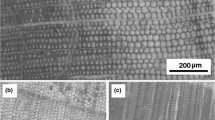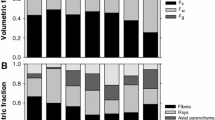Abstract
To quantify night-time (S n) and diurnal (S d) tree water uptake, two sets of sap flow sensors (heat-pulse compensated) were installed per tree in the north-east and south-west sides of the trunk in three trees per treatment. There were two treatments: (1) control, irrigated with 100 % ETc (T100), and (2) deficit, irrigated at 60 % ETc (T60) with daily irrigations at the peak atmospheric demand (December–January). Normalised S n by trees was in the range of 15–25 % throughout the season, compared to normalised S d, for T100 and T60, respectively. Furthermore, S n was parabolically correlated to plant water status from the previous day, measured as midday stem water potential. We also found strong correlations between S n and nocturnal vapour pressure deficit for T100 and T60, indicating that nocturnal transpiration was significant for both treatments. Differences in S n were observed for the NE and SW sensors for T60, being significantly less for the NE side (sunny side) compared to the SW side (more shaded). No differences were observed for T100 regarding probe positioning.





Similar content being viewed by others
References
Benyon RG (1999) Nighttime water use in an irrigated Eucalyptus grandis plantation. Tree Physiol 19(13):853–859
Brunetti M, Buffoni L, Maugeri M, Nanni T (2000) Trends of minimum and maximum daily temperatures in Italy from 1865 to 1996. Theoret Appl Climatol 66(1):49–60
Bucci SJ et al (2004) Processes preventing nocturnal equilibration between leaf and soil water potential in tropical savanna woody species. Tree Physiol 24(10):1119–1127
Bucci SJ et al (2005) Mechanisms contributing to seasonal homeostasis of minimum leaf water potential and predawn disequilibrium between soil and plant water potential in Neotropical savanna trees. Trees Struct Funct 19(3):296–304
Caird MA, Richards JH, Donovan LA (2007) Nighttime stomatal conductance and transpiration in C3 and C4 plants. Plant Physiol 143(1):4–10
Collins MJ, Fuentes S, Barlow EWR (2009) Partial rootzone drying and deficit irrigation increase stomatal sensitivity to vapour pressure deficit in anisohydric grapevines. Funct Plant Biol 37:129–138
Daley MJ, Phillips NG (2006) Interspecific variation in nighttime transpiration and stomatal conductance in a mixed New England deciduous forest. Tree Physiol 26(4):411–419
Davies WJ, Wilkinson S, Loveys B (2002) Stomatal control by chemical signalling and the exploitation of this mechanism to increase water use efficiency in agriculture. New Phytol 153(3):449–460
Dodd IC (2007) Soil moisture heterogeneity during deficit irrigation alters root-to-shoot signalling of abscisic acid. Funct Plant Biol 34(5):439–448
Dodd IC, Egea G, Davies WJ (2008a) Abscisic acid signalling when soil moisture is heterogeneous: decreased photoperiod sap flow from drying roots limits abscisic acid export to the shoots. Plant, Cell Environ 31(9):1263–1274
Dodd IC, Egea G, Davies WJ (2008b) Accounting for sap flow from different parts of the root system improves the prediction of xylem ABA concentration in plants grown with heterogeneous soil moisture. J Exp Bot 59(15):4083–4093
Donovan LA et al (1999) Predawn disequilibrium between plant and soil water potentials in two cold-desert shrubs. Oecologia 120(2):209–217
Donovan LD, Linton ML, Richards JR (2001) Predawn plant water potential does not necessarily equilibrate with soil water potential under well-watered conditions. Oecologia 129(3):328–335
Donovan LA, Richards JH, Linton MJ (2003) Magnitude and mechanisms of disequilibrium between predawn plant and soil water potentials. Ecology 84(2):463–470
Easterling DR et al (1997) Maximum and minimum temperature trends for the globe. Science 277(5324):364–367
Egea G, Dodd IC, González-Real MM, Domingo R, Baille A (2011) Partial rootzone drying improves almond tree leaf-level water use efficiency and afternoon water status compared with regulated deficit irrigation. Funct Plant Biol 38(5):372–385
Escalona J et al. (2012) Responses of leaf night respiration and transpiration to water stress in Vitis vinifera L. Agric Water Manag 118:50–58
Fisher JB, Baldocchi DD, Misson L, Dawson TE, Goldstein AH (2007) What the towers don’t see at night: nocturnal sap flow in trees and shrubs at two AmeriFlux sites in California. Tree Physiol 27(4):597–610
Flexas J et al (2002) Effects of drought on photosynthesis in grapevines under field conditions: an evaluation of stomatal and mesophyll limitations. Funct Plant Biol 29(4):461–471
Fuentes S, Palmer AR, Taylor D, Zeppel M, Whitley R, Eamus D (2008) An automated procedure for estimating the leaf area index (LAI) of woodland ecosystems using digital imagery, Matlab® programming and its application to an examination of the relationship between remotely sensed and field measurements of LAI. Funct Plant Biol 35:1070–1079
Fuentes S, De Bei R, Collins M, Escalona JM, Medrano H, Tyerman S (2013) Night-time responses to water supply in grapevines (Vitis vinifera L.) under deficit irrigation and partial root-zone drying. Irrig Sci (under review)
FuBeder A, Wartinger A, Hartung W, Schulze ED, Heilmeier H (1992) Cytokinins in the xylem sap of desert-grown almond (Prunus dulcis) trees: daily courses and their possible interactions with abscisic acid and leaf conductance. New Phytol 122(1):45–52
Fulton A et al (2001) Rapid equilibration of leaf and stem water potential under field conditions in almonds, walnuts and prunes. Hort Technol 11(4):609–614
Green S (1998) Measurements of sap flow by the heat-pulse method. HortResearch, Palmerston North
Green SR, McNaughton KG, Clothier BE (1989) Observations of night-time water use in kiwifruit vines and apple trees. Agric For Meteorol 48(3&4):251–261
Green S, Clothier B, Jardine B (2003) Theory and practical application of heat pulse to measure sap flow. Agron J 95(6):1371–1379
Kavanagh KL, Pangle R, Schotzko AD (2007) Nocturnal transpiration causing disequilibrium between soil and stem predawn water potential in mixed conifer forests of Idaho. Tree Physiol 27(4):621–629
Liang JS, Zhang JH (1999) The relations of stomatal closure and reopening to xylem ABA concentration and leaf water potential during soil drying and rewatering. Plant Growth Regul 29(1–2):77–86
Loveys BR, Dry PR, Stoll M, McCarthy MG (2000) Using plant physiology to improve the water use efficiency of horticultural crops. Acta Horticulturae 537(1):187–197
Mayo NE, Scott SC, Ahmed S (2009) Case management poststroke did not induce response shift: the value of residuals. J Clin Epidemiol 62(11):1148–1156
McCarthy MG, Loveys BR, Dry PR, Stoll M (2002) Regulated deficit irrigation and partial rootzone drying as irrigation management techniques for grapevines. FAO, Rome
Monzon JP, Sadras VO, Andrade FH (2006) Fallow soil evaporation and water storage as affected by stubble in sub-humid (Argentina) and semi-arid (Australia) environments. Field Crops Res 98(2&3):83–90
Moore GW, Cleverly JR, Owens MK (2008) Nocturnal transpiration in riparian Tamarix thickets authenticated by sap flux, eddy covariance and leaf gas exchange measurements. Tree Physiol 28(4):521–528
Nortes PA, Perez-Pastor A, Egea G, Conejero W, Domingo R (2005) Comparison of changes in stem diameter and water potential values for detecting water stress in young almond trees. Agric Water Manag 77(1&3):296–307
Oren R et al (1999) Survey and synthesis of intra- and inter-specific variation in stomatal sensitivity to vapour pressure deficit. Plant, Cell Environ 22(12):1515–1526
Phillips NG, Lewis JD, Logan BA, Tissue DT (2010) Inter- and intra-specific variation in nocturnal water transport in Eucalyptus. Tree Physiol 30(5):586–596
Rayment GE, Higginson FR (1992) Australian laboratory handbook of soil and water chemical methods. Inkata Press, Melbourne, p 330
Remorini D, Massai R (2003) Comparison of water status indicators for young peach trees. Irrig Sci 22(1):39–46
Rodrigues ML et al (2008) Hydraulic and chemical signalling in the regulation of stomatal conductance and plant water use in field grapevines growing under deficit irrigation. Funct Plant Biol 35(7):565–579
Rogiers SY, Greer DH, Hutton RJ, Landsberg JJ (2009) Does night-time transpiration contribute to anisohydric behaviour in a Vitis vinifera cultivar? J Exp Bot 60(13):3751–3763
Romero P, Navarro JM, Garcia F, Ordaz PB (2004) Effects of regulated deficit irrigation during the pre-harvest period on gas exchange, leaf development and crop yield of mature almond trees. Tree Physiol 24(3):303–312
Romero P, Dodd IC, Martinez-Cutillas A (2012) Contrasting physiological effects of partial root zone drying in field-grown grapevine (Vitis vinifera L. cv. Monastrell) according to total soil water availability. J Exp Bot 63(11):4071–4083
Sadras VO, Moran MA (2012) Elevated temperature decouples anthocyanins and sugars in berries of Shiraz and Cabernet Franc. Aust J Grape Wine Res 18:115–122
Saxton KE, Rawls WJ (2006) Soil water characteristic estimates by texture and organic matter for hydrologic solutions. Soil Sci Soc Am J 70(5):1569–1578
Saxton KE, Willey PH (2004) Agricultural wetland and pond hydrologic analysis using SPAW model. ASAE, St Paul
Sellin A (1999) Does pre-dawn water potential reflect conditions of equilibrium in plant and soil water status? Acta Oecologica 20(1):51–59
Shackel KA (1995) Plant water status as an index of irrigation needs in deciduous fruit trees. HortScience 30(4):905
Snyder KA, Richards JH, Donovan LA (2003) Night, Äêtime conductance in C3 and C4 species: do plants lose water at night? J Exp Bot 54(383):861–865
Sousa TA, Oliveira MT, Pereira JM (2006) Physiological indicators of plant water status of irrigated and non-irrigated grapevines grown in a low rainfall area of Portugal. Plant Soil 282(1–2):127–134
Stevens R, Ewenz C, Grigson G, Conner S (2012) Water use by an irrigated almond orchard. Irrig Sci 30(3):189–200
Tang K, Beaton DE, Gignac MAM, Bombardier C (2011) Rasch analysis informed modifications to the Work Instability Scale for Rheumatoid Arthritis for use in work-related upper limb disorders. J Clin Epidemiol 64(11):1242–1251
Wang H et al (2008) Nocturnal sap flow characteristics and stem water recharge of Acacia mangium. Frontiers For China 3(1):72–78
Wartinger A, Heilmeier H, Hartung W, Schulze ED (1990) Daily and seasonal courses of leaf conductance and abscisic acid in the xylem sap of almond trees [Prunus dulcis (Miller) D. A. Webb] under desert conditions. New Phytol 116(4):581–587
Wilkinson S, Davies WJ (2002) ABA-based chemical signalling: the co-ordination of responses to stress in plants. Plant, Cell Environ 25(2):195–210
Zeppel M, Tissue D, Taylor D, Macinnis-Ng C, Eamus D (2010) Rates of nocturnal transpiration in two evergreen temperate woodland species with differing water-use strategies. Tree Physiol 30(8):988–1000
Zhang J, Zhang X (1994) Can early wilting of old leaves account for much of the ABA accumulation in flooded pea plants? J Exp Bot 45(9):1335–1342
Acknowledgments
We would like to acknowledge Almond Board of Australia, Berri, South Australia, for funding the project on “Minimising environmental foot prints from irrigated almonds by using new method and tools” of which the sap flow studies reported here were a part. We would also like to acknowledge Ben Brown and Brett Rosenzweig from the Almond Board of Australia for all their support and assistance for the experiment.
Author information
Authors and Affiliations
Corresponding author
Additional information
Communicated by I. Dodd.
Rights and permissions
About this article
Cite this article
Fuentes, S., Mahadevan, M., Bonada, M. et al. Night-time sap flow is parabolically linked to midday water potential for field-grown almond trees. Irrig Sci 31, 1265–1276 (2013). https://doi.org/10.1007/s00271-013-0403-3
Received:
Accepted:
Published:
Issue Date:
DOI: https://doi.org/10.1007/s00271-013-0403-3




